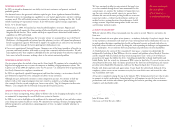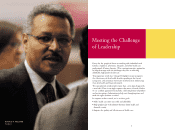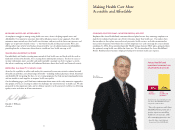Aetna 2004 Annual Report Download - page 15
Download and view the complete annual report
Please find page 15 of the 2004 Aetna annual report below. You can navigate through the pages in the report by either clicking on the pages listed below, or by using the keyword search tool below to find specific information within the annual report.
27
Improving Evidence for
Health Care Decisions
SEAN R. TUNIS, M.D., M.Sc.
Chief Medical Officer
Centers for Medicare and Medicaid Services
As Americans take increasing personal responsibility for health
care decision making, it becomes essential for patients and their
physicians to have reliable information about the risks, benefits
and costs of their clinical alternatives. Payers and policy makers
also must have accurate evidence with which to make decisions
about benefits, coverage and payment. With the rate of national
spending rising substantially faster than inflation and wages, the
importance of getting good value for health care spending becomes
ever more urgent, and the key to obtaining good value is good
information about what works.
Examples of common questions that must be routinely answered
by patients and physicians include:
Would it be better to begin drug therapy for mild to moderate
osteoporosis or begin a regimen of diet and exercise? Which specific order or combination of drugs
is associated with the lowest risk of long-term complication of diabetes or hypertension? Will a
topical compound help a chronic leg wound heal more quickly than standard wound care? Would
obtaining a PET scan in addition to CT and MRI for staging a particular cancer influence the
recommended treatment regimen? Will a surgery have better short-term and long-term results if
done using minimally invasive techniques rather than the standard open surgical approach? The
answers to these questions can be determined only through well-designed clinical research.
It would be natural to assume that all such questions are systematically identified and answered as
part of the clinical research activity pursued in the United States. And, in fact, many similar
questions are addressed through publicly and privately funded clinical research. But the number of
important clinical questions is sufficiently large that there are many critical issues that are central to
the decisions made daily by patients and physicians for which adequate information is not available.
The recent unexpected finding that use of rofecoxib (Vioxx) and related drugs increases the risk of
heart attacks emphasizes the need for efficient, reliable mechanisms to quickly answer important
questions about widely used medical products. Clinical research that is explicitly designed to answer
common questions faced by decision makers has been referred to as “practical clinical research.”
There currently is no public or private organization whose mission is to determine which critical clinical
research questions need to be answered and how we can expand the capacity to answer them.
To address this problem, health care stakeholders recently have begun a discussion about how to
establish a systematic effort to increase the supply of reliable evidence for decision makers through
support of simple, real-world prospective clinical trials and registries. It will take the combined
knowledge, skills and resources of patient advocacy organizations, medical professional organizations,
product developers, health plans, employers, clinical researchers and others to ensure success in this
enterprise. The quality and relevance of the information generated by this effort will be critical for
the quality of health care decisions, which, in turn, will determine the quality and value of health
care provided in this country.
The key to obtaining
good value is good
information about
what works.
























